Liberal Democratic Party (Japan)
Liberal Democratic Party 自由民主党 or 自民党 | |
|---|---|
 | |
| President | Shinzō Abe |
| Secretary-General | Toshihiro Nikai |
| Councillors leader | Hidehisa Otsuji |
| Representatives leader | Shinzō Abe |
| Founded | 15 November 1955 |
| Headquarters | 11-23, Nagatachō 1-chome, Chiyoda, Tokyo 100-8910, Japan |
| Membership (2012) | 800,000 |
| Ideology |
Conservatism Japanese nationalism[1] National conservatism Liberal conservatism[2] |
| Political position | Centre-right[3] to Right-wing[4] |
| International affiliation | None |
| Colors | Green and Blue |
| Councillors |
122 / 242 |
| Representatives |
290 / 475 |
| Prefectural assembly members[5] |
1,338 / 2,675 |
| City and town assembly members[5] |
2,013 / 30,490 |
| Website | |
| jimin.jp | |
The Liberal Democratic Party of Japan (自由民主党 Jiyū-Minshutō), frequently abbreviated to LDP or Jimintō (自民党), is a conservative[6] political party in Japan. It has near continuously been in power since its foundation in 1955, with the exception of a period between 1993 and 1994, and again from 2009 to 2012. In the 2012 election it regained control of government. It holds 291 seats in the lower house and 121 seats in the upper house, with the Komeito the governing coalition has the supermajority in both houses. Prime Minister Shinzō Abe and many present and former LDP ministers are also known members of Nippon Kaigi, a controversial monarchist and negationist organization.[7]
The LDP is not to be confused with the now-defunct Liberal Party (自由党 Jiyūtō), which merged with the Democratic Party of Japan (民主党 Minshutō), now the Democratic Party (民進党 Minshintō), the main opposition party.[8]
History
Beginnings
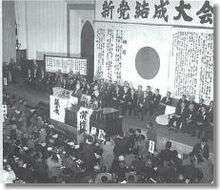
The LDP was formed in 1955 as a merger between two of Japan's political parties, the Liberal Party (自由党 Jiyutō, 1945–1955, led by Shigeru Yoshida) and the Japan Democratic Party (日本民主党 Nihon Minshutō, 1954–1955, led by Ichirō Hatoyama), both right-wing conservative parties, as a united front against the then popular Japan Socialist Party (日本社会党 Nipponshakaitō), now Socialist Democratic Party (社会民主党 Shakaiminshutō). The party won the following elections, and Japan's first conservative government with a majority was formed by 1955. It would hold majority government until 1993.
The LDP began with reforming Japan's international relations, ranging from entry into the United Nations, to establishing diplomatic ties with the Soviet Union. Its leaders in the 1950s also made the LDP the main government party, and in all the elections of the 1950s, the LDP won the majority vote, with the only other opposition coming from the left-wing politics, made up of the Japan Socialist Party and the Japanese Communist Party.
From the 1950s through the 1970s, the United States Central Intelligence Agency spent millions of dollars attempting to influence elections in Japan to favor the LDP against more leftist parties such as the Socialists and the Communists,[9][10] although this was not revealed until the mid-1990s when it was exposed by The New York Times.[11]
1960s to 1990s
For the majority of the 1960s, the LDP (and Japan) were led by Eisaku Satō, beginning with the hosting of the 1964 Summer Olympics in Tokyo, and ending in 1972 with Japanese neutrality in the Vietnam War and with the beginning of the Japanese asset price bubble. By the end of the 1970s, the LDP went into its decline, where even though it held the reins of government many scandals plagued the party, while the opposition (now joined with the Komeito (Former)) gained momentum.
In 1976, in the wake of the Lockheed bribery scandals, a handful of younger LDP Diet members broke away and established their own party, the New Liberal Club (Shin Jiyu Kurabu). A decade later, however, it was reabsorbed by the LDP.
By the late 1970s, the Japan Socialist Party, the Japanese Communist Party, and the Komeito along with the international community used major pressure to have Japan switch diplomatic ties from the Republic of China to the People's Republic of China. During the 1980s, the LDP was responsible for Japan's unprecedented economic growth, and the successful economy.
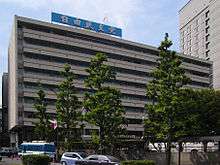
By the early 1990s, the LDP's nearly four decades in power allowed it to establish a highly stable process of policy formation. This process would not have been possible if other parties had secured parliamentary majorities. LDP strength was based on an enduring, although not unchallenged, coalition of big business, small business, agriculture, professional groups, and other interests. Elite bureaucrats collaborated closely with the party and interest groups in drafting and implementing policy. In a sense, the party's success was a result not of its internal strength but of its weakness. It lacked a strong, nationwide organization or consistent ideology with which to attract voters. Its leaders were rarely decisive, charismatic, or popular. But it functioned efficiently as a locus for matching interest group money and votes with bureaucratic power and expertise. This arrangement resulted in corruption, but the party could claim credit for helping to create economic growth and a stable, middle-class Japan.
Out of power
But by 1993, the end of the miracle economy and other reasons (e.g. Recruit scandal) led to the LDP losing its majority in that year's general election.
Seven opposition parties—including several formed by LDP dissidents—formed a government headed by LDP dissident Morihiro Hosokawa of the Japan New Party. However, the LDP was still far and away the largest party in the House of Representatives, with well over 200 seats; no other party crossed the 80-seat mark.
In 1994, the Socialist Party and New Party Sakigake left the ruling coalition, joining the LDP in the opposition. The remaining members of the coalition tried to stay in power as a makeshift minority government, but this failed when the LDP and the Socialists, bitter rivals for 40 years, formed a majority coalition. The new government was dominated by the LDP, but it allowed a Socialist to occupy the Prime Minister's chair until 1996, when the LDP's Ryutaro Hashimoto took over.
1996–2009
In the 1996 election, the LDP made some gains, but was still 12 seats short of a majority. However, no other party could possibly form a government, and Hashimoto formed a solidly LDP minority government. Through a series of floor-crossings, the LDP regained its majority within a year.
The party was practically unopposed until 1998, when the opposition Democratic Party of Japan was formed. Since then the opposition has been gaining momentum, especially in the 2003 and 2004 Parliamentary Elections.
In the dramatically paced 2003 House of Representatives elections, the LDP won 237 seats, while the DPJ won 177 seats. In the 2004 House of Councillors elections, in the seats up for grabs, the LDP won 49 seats and the DPJ 50, though in all seats (including those uncontested) the LDP still had a total of 114. Because of this electoral loss, former Secretary General Shinzō Abe turned in his resignation, but Party President Koizumi merely demoted him in rank, and he was replaced by Tsutomu Takebe.
On 10 November 2003, the New Conservative Party (Hoshu Shintō) was absorbed into the LDP, a move which was largely because of the New Conservative Party's poor showing in the 2003 general election. The LDP formed a coalition with the conservative Buddhist New Komeito.
After a victory in the Japan general election, 2005, the LDP held an absolute majority in the Japanese House of Representatives and formed a coalition government with the New Komeito Party. Abe succeeded then-Prime Minister Junichirō Koizumi as the president of the party on 20 September 2006. The party suffered a major defeat in the election of 2007, however, and lost its majority in the upper house for the first time in its history.
The LDP remained the largest party in both houses of the Diet, until 29 July 2007, when the LDP lost its majority in the upper house.[12]
In a party leadership election held on 23 September 2007, the LDP elected Yasuo Fukuda as its President. Fukuda defeated Tarō Asō for the post, receiving 330 votes against 197 votes for Aso.[13][14] However Fukuda resigned suddenly in September 2008, and Asō became Prime Minister after winning the presidency of the LDP in a 5-way election.
In the 2009 general election, the LDP was roundly defeated, winning only 118 seats—easily the worst defeat of a sitting government in modern Japanese history, and also the first real transfer of political power in the post-war era. Accepting responsibility for this severe defeat, Aso announced his resignation as LDP president on election night. Sadakazu Tanigaki was elected leader of the party on 28 September 2009,[15] after a three way race, becoming only the second LDP leader who was not simultaneously prime minister.
Recent political history
The party's support continued to decline, with prime ministers changing rapidly, and in the 2009 House of Representatives elections the LDP lost its majority, winning only 118 seats, marking the only time they would be out of the majority other than a brief period in 1993.[16][17] Since that time, numerous party members have left to join other parties or form new ones, including Your Party (みんなの党 Minna no Tō), the Sunrise Party of Japan (たちあがれ日本 Tachiagare Nippon),[18] and the New Renaissance Party (新党改革 Shintō Kaikaku). The party had some success in the 2010 House of Councilors election, netting 13 additional seats and denying the DPJ a majority.[19][20] The LDP returned to power with its ally New Komeito after winning a clear majority in the lower house general election on 16 December 2012 after just over three years in opposition. Shinzo Abe became Prime Minister for the second time.[21]
In July 2015, the party pushed for expanded military powers to fight in foreign conflict through Shinzo Abe and the support of Komeito party.[22]
Ideology
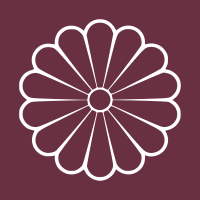
The LDP has not espoused a well-defined, unified ideology or political philosophy, due to its long-term regimes. Its members hold a variety of positions that could be broadly defined as being to the right of the opposition parties. The LDP traditionally identified itself with a number of general goals: rapid, export-based economic growth; close cooperation with the United States in foreign and defense policies; and several newer issues, such as administrative reform. Administrative reform encompassed several themes: simplification and streamlining of government bureaucracy; privatization of state-owned enterprises; and adoption of measures, including tax reform, in preparation for the expected strain on the economy posed by an aging society. Other priorities in the early 1990s included the promotion of a more active and positive role for Japan in the rapidly developing Asia-Pacific region, the internationalization of Japan's economy by the liberalization and promotion of domestic demand (expected to lead to the creation of a high-technology information society) and the promotion of scientific research. A business-inspired commitment to free enterprise was tempered by the insistence of important small business and agricultural constituencies on some form of protectionism and subsidies.[23] In addition, the LDP opposes the legalization of same-sex marriage.[24]
Structure
At the apex of the LDP's formal organization is the president (総裁 sōsai), who can serve two three-year terms (The presidential term was increased from two years to three years in 2002). When the party has a parliamentary majority, the party president is the prime minister. The choice of party president is formally that of a party convention composed of Diet members and local LDP figures, but in most cases, they merely approved the joint decision of the most powerful party leaders. To make the system more democratic, Prime Minister Takeo Fukuda introduced a "primary" system in 1978, which opened the balloting to some 1.5 million LDP members. The process was so costly and acrimonious, however, that it was subsequently abandoned in favor of the old "smoke-filled room" method — so-called in allusion to the notion of closed discussions held in small rooms filled with tobacco smoke.
After the party president, the most important LDP officials are the Secretary-General (kanjicho), and the chairmen of the LDP Executive Council (somukaicho) and of the Policy Affairs Research Council or "PARC" (政務調査会 seimu chōsakai).
The LDP is the most "traditionally Japanese" of the political parties because it relies on a complex network of patron-client (oyabun-kobun) relationships on both national and local levels. Nationally, a system of factions in both the House of Representatives and the House of Councillors ties individual Diet members to powerful party leaders. Locally, Diet members have to maintain koenkai (local support groups) to keep in touch with public opinion and gain votes and financial backing. The importance and pervasiveness of personal ties between Diet members and faction leaders and between citizens and Diet members gives the party a pragmatic "you scratch my back, I'll scratch yours" character. Its success depends less on generalized mass appeal than on the so-called sanban (three "ban"): jiban (a strong, well-organized constituency), kaban (a briefcase full of money), and kanban (prestigious appointment, particularly on the cabinet level).
Factions
The LDP has 3 major factions:
Heisei Kenkyukai (from the Liberal Party – Right Liberal)
- Supported by local farmers, the construction industry, blue-collar workers, the defense industry, Japan Post workers, and discriminated village peoples.
- This faction led economic development from 1960 to 1988. They promote international cooperation with China and Korea, a Gasoline Tax, construction of Highways/Shinkansen (Bullet Train), and protection of small farmers, Japan Post workers and discriminated peoples.
- Founded by diplomat Shigeru Yoshida. Succeeded by Eisaku Satō, Kakuei Tanaka, Ryutaro Hashimoto, Shigeru Ishiba.
Kouchi Kai (from Liberal Party – Keynesian economics and Right Liberal)
- Supported by the established Liberal party of the bureaucracy, white-collar workers, doctors, small merchants and small factory people.
- This faction led economic development from 1960 to 1988. They promote international cooperation with China and Korea, a Government bond/Consumption Tax for National Medical care and National Banks which financially support small firms, as well as Free trade Policy.
- Founded by diplomat Shigeru Yoshida. Succeeded by Hayato Ikeda, Kiichi Miyazawa, Sadakazu Tanigaki, Makoto Koga.
Seiwa Seisaku Kenkyukai (from Japan Democratic Party – Nationalist)
- Supported by Japan Business Federation, established authoritarian bureaucracy, war widows from World War II.
- This faction promotes decreasing taxes for high income taxpayers, decreasing taxes for large companies, depending on the US for national defense issues, visits to Yasukuni Shrine in order to garner support from Nationalist voters without any special interest payments, returning the constitution to support the political system of the pre-World War II era, decreasing road/railway construction, decreasing medical care, eliminating overtime pay for white-collar workers, changing permanent employment to temporary employment, eliminating labor unions, free trade for car exports, removing protection for small farmers, privatization of Japan Post and the layoff of Japan Post workers.
- 1955 GHQ changed their policy from anti-fascist to anti-communist, and released Nobusuke Kishi (Class A war criminals, a member of Hideki Tōjō's Militarist Cabinet, father of Shintarō Abe and grandfather of Shinzō Abe) from Sugamo Prison. Kishi founded the Japan Democratic Party (No relation to the current JDP)
- The faction was suppressed by Heisei Seisaku Kenkyukai and Kochikai from 1960 to 1990 but because of a failure of the Heisei Seisaku Kenkyukai and Kochikai leadership it led the LDP from 2002 to 2008, mainly under Junichirō Koizumi.
- Founded by Nobusuke Kishi. Succeeded by Takeo Fukuda, Junichirō Koizumi, Shinzō Abe, Yasuo Fukuda.
Membership
The LDP had over five million party members in 1990, but by 2012 it had around 800,000.[25]
Performance in national elections until 1993
Election statistics show that, while the LDP had been able to secure a majority in the twelve House of Representatives elections from May 1958 to February 1990, with only three exceptions (December 1976, October 1979, and December 1983), its share of the popular vote had declined from a high of 57.8 percent in May 1958 to a low of 41.8 percent in December 1976, when voters expressed their disgust with the party's involvement in the Lockheed scandal. The LDP vote rose again between 1979 and 1990. Although the LDP won an unprecedented 300 seats in the July 1986 balloting, its share of the popular vote remained just under 50 percent. The figure was 46.2 percent in February 1990. Following the three occasions when the LDP found itself a handful of seats shy of a majority, it was obliged to form alliances with conservative independents and the breakaway New Liberal Club. In a cabinet appointment after the October 1983 balloting, a non-LDP minister, a member of the New Liberal Club, was appointed for the first time. In 18 July 1993, lower house elections, the LDP fell so far short of a majority that it was unable to form a government.
In the upper house, the July 1989 election represented the first time that the LDP was forced into a minority position. In previous elections, it had either secured a majority on its own or recruited non-LDP conservatives to make up the difference of a few seats.
The political crisis of 1988–89 was testimony to both the party's strength and its weakness. In the wake of a succession of issues—the pushing of a highly unpopular consumer tax through the Diet in late 1988, the Recruit insider trading scandal, which tainted virtually all top LDP leaders and forced the resignation of Prime Minister Takeshita Noboru in April (a successor did not appear until June), the resignation in July of his successor, Uno Sōsuke, because of a sex scandal, and the poor showing in the upper house election—the media provided the Japanese with a detailed and embarrassing dissection of the political system. By March 1989, popular support for the Takeshita cabinet as expressed in public opinion polls had fallen to 9 percent. Uno's scandal, covered in magazine interviews of a "kiss and tell" geisha, aroused the fury of female voters.
Uno's successor, the eloquent if obscure Kaifu Toshiki, was successful in repairing the party's battered image. By January 1990, talk of the waning of conservative power and a possible socialist government had given way to the realization that, like the Lockheed affair of the mid-1970s, the Recruit scandal did not signal a significant change in who ruled Japan. The February 1990 general election gave the LDP, including affiliated independents, a comfortable, if not spectacular, majority: 275 of 512 total representatives.
In October 1991, Prime Minister Kaifu Toshiki failed to attain passage of a political reform bill and was rejected by the LDP, despite his popularity with the electorate. He was replaced as prime minister by Miyazawa Kiichi, a long-time LDP stalwart. Defections from the LDP began in the spring of 1992, when Hosokawa Morihiro left the LDP to form the Japan New Party. Later, in the summer of 1993, when the Miyazawa government also failed to pass political reform legislation, thirty-nine LDP members joined the opposition in a no-confidence vote. In the ensuing lower house election, more than fifty LDP members formed the Shinseitō and the Sakigake parties, denying the LDP the majority needed to form a government.
Presidents of the Liberal Democratic Party
With the exception of Yohei Kono and Sadakazu Tanigaki, every President of the LDP (自由民主党総裁 Jiyū-Minshutō Sōsai) has also served as Prime Minister of Japan.
| No. | Name | Term of office | Image | Election results | |
|---|---|---|---|---|---|
| Took Office | Left Office | ||||
| Interim President Committee | |||||
| - | Ichirō Hatoyama 鳩山 一郎 Hatoyama Ichirō |
15 November 1955 | 5 April 1956 | 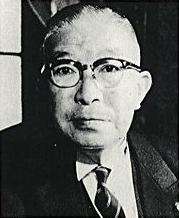 |
Interim President Committee |
| Bukichi Miki 三木 武吉 Miki Bukichi |
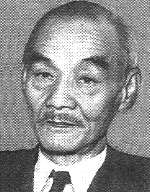 | ||||
| Banboku Oono 大野 伴睦 Ōno Banboku |
 | ||||
| Taketora Ogata 緒方 竹虎 Ogata Taketora |
28 January 1956 |  | |||
| Tsuruhei Matsuno 松野 鶴平 Matsuno Tsuruhei |
10 February 1956 | 5 April 1956 |  | ||
| President | |||||
| 1 | Ichirō Hatoyama 鳩山 一郎 Hatoyama Ichirō |
5 April 1956 | 14 December 1956 |  |
Unopposed Ichirō Hatoyama - 394 |
| 2 | Tanzan Ishibashi 石橋 湛山 Ishibashi Tanzan |
14 December 1956 | 21 March 1957 |  |
Tanzan Ishibashi - 258 Nobusuke Kishi - 251 |
| 3 | Nobusuke Kishi 岸 信介 Kishi Nobusuke |
21 March 1957 | 14 July 1960 |  |
1957: Nobusuke Kishi - 471 Kenzō Matsumura - 2 Tokutaro Kitamura - 1 Mitsujirō Ishii - 1 1959: |
| 4 | Hayato Ikeda 池田 勇人 Ikeda Hayato |
14 July 1960 | 1 December 1964 | 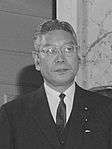 |
1960: Hayato Ikeda - 302 Mitsujirō Ishii - 194 1962: July 1964: |
| 5 | Eisaku Satō 佐藤 榮作 Satō Eisaku |
1 December 1964 | 5 July 1972 |  |
1964 negotiations: Eisaku Satō - Aiichirō Fujiyama - Ichirō Kōno - 1966: 1968: 1970: |
| 6 | Kakuei Tanaka 田中 角榮 Tanaka Kakuei |
5 July 1972 | 4 December 1974 | 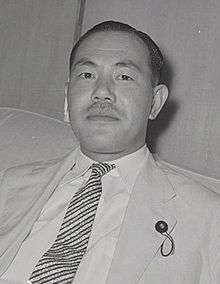 |
Tanaka Kakuei - 282 Fukuda Takeo - 180 |
| 7 | Takeo Miki 三木 武夫 Miki Takeo |
4 December 1974 | 23 December 1976 |  |
1974 negotiations: Takeo Miki - Fukuda Takeo - Masayoshi Ōhira - Yasuhiro Nakasone - |
| 8 | Takeo Fukuda 福田 赳夫 'Fukuda Takeo |
23 December 1976 | 1 December 1978 |  |
1976 negotiations: Fukuda Takeo - Masayoshi Ōhira - |
| 9 | Masayoshi Ōhira 大平 正芳 Ōhira Masayoshi |
1 December 1978 | 12 June 1980 | 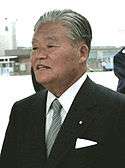 |
1978: Masayoshi Ōhira - 748 Fukuda Takeo - 638 Yasuhiro Nakasone - 93 Toshio Kōmoto - 46 |
| — | Eiichi Nishimura 西村 英一 Nishimura Eiichi (Acting) |
12 June 1980 | 15 July 1980 | Acting | |
| 10 | Zenko Suzuki 鈴木 善幸 Suzuki Zenkō |
15 July 1980 | 25 November 1982 |  |
1980 negotiations: Zenko Suzuki - Kiichi Miyazawa - Yasuhiro Nakasone - Toshio Kōmoto - Nov. 1980: |
| 11 | Yasuhiro Nakasone 中曾根 康弘 Nakasone Yasuhiro |
25 November 1982 | 31 October 1987 |  |
1982: Yasuhiro Nakasone - 57.6% Toshio Kōmoto - 27.2% Shintarō Abe - 8.2% Ichirō Nakagawa - 6.8% 1984: 1986: |
| 12 | Noboru Takeshita 竹下 登 Takeshita Noboru |
31 October 1987 | 2 June 1989 |  |
1987 negotiations: Noboru Takeshita - Shintarō Abe - Kiichi Miyazawa - |
| 13 | Sōsuke Uno 宇野 宗佑 Uno Sōsuke |
2 June 1989 | 8 August 1989 |  |
1989 negotiations: Sōsuke Uno - Masayoshi Itō - |
| 14 | Toshiki Kaifu 海部 俊樹 Kaifu Toshiki |
8 August 1989 | 30 October 1991 | 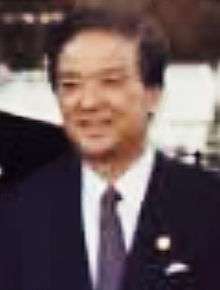 |
Toshiki Kaifu - 279 Yoshirō Hayashi - 120 Shintarō Ishihara - 48 |
| 15 | Kiichi Miyazawa 宮澤 喜一 Miyazawa Kiichi |
31 October 1991 | 29 July 1993 |  |
Kiichi Miyazawa - 285 Michio Wantanabe - 120 Hiroshi Mitsuzuka - 87 |
| 16 | Yōhei Kōno 河野 洋平 Kōno Yōhei |
29 July 1993 | 1 October 1995 |  |
Yōhei Kōno - 208 Michio Wantanabe - 159 |
| 17 | Ryutaro Hashimoto 橋本 龍太郎 Hashimoto Ryūtarō |
1 October 1995 | 24 July 1998 | 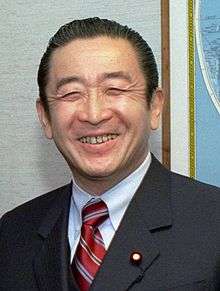 |
Unopposed |
| 18 | Keizō Obuchi 小渕 恵三 Obuchi Keizō |
24 July 1998 | 5 April 2000 |  |
1998: Keizō Obuchi - 225 Seiroku Kajiyama - 102 Junichiro Koizumi - 84 1999: |
| 19 | Yoshirō Mori 森 喜朗 Mori Yoshirō |
5 April 2000 | 24 April 2001 | 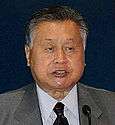 |
2000 negotiations: Yoshirō Mori - Mikio Aoki - Masakuni Murakami - Hiromu Nonaka - Shizuka Kamei - |
| 20 | Junichiro Koizumi 小泉 純一郎 Koizumi Jun'ichirō |
24 April 2001 | 20 September 2006 | 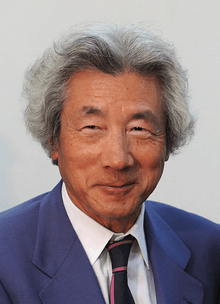 |
2001: Junichiro Koizumi - 298 Ryutaro Hashimoto - 155 Tarō Asō - 31 2003: |
| 21 | Shinzō Abe 安倍 晋三 Abe Shinzō |
20 September 2006 | 26 September 2007 | 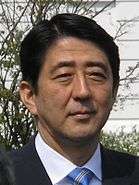 |
see election Sep 2006 Shinzō Abe - 464 Tarō Asō - 136 Sadakazu Tanigaki - 102 |
| 22 | Yasuo Fukuda 福田 康夫 Fukuda Yasuo |
26 September 2007 | 22 September 2008 |  |
see election 2007 Yasuo Fukuda - 330 Tarō Asō - 197 |
| 23 | Tarō Asō 麻生 太郎 Asō Tarō |
22 September 2008 | 16 September 2009 | .jpg) |
see election 2008 Tarō Asō - 351 Kaoru Yosano - 66 Yuriko Koike - 46 Nobuteru Ishihara - 37 Shigeru Ishiba - 25 |
| 24 | Sadakazu Tanigaki 谷垣 禎一 Tanigaki Sadakazu |
28 September 2009 | 26 September 2012 |  |
see election 2009 Sadakazu Tanigaki - 300 Taro Kono - 144 Yasutoshi Nishimura - 58 |
| 25 | Shinzō Abe 安倍 晋三 Abe Shinzō |
26 September 2012 | Incumbent | 2012: Shinzō Abe - 108 Shigeru Ishiba - 89 2015: | |
Election results
General election results
| Election | Leader | # of candidates | # of seats won | # of Constituency votes | % of Constituency vote | # of PR Block votes | % of PR Block vote | Government |
|---|---|---|---|---|---|---|---|---|
| 1958 | Nobusuke Kishi | 413 | 289 / 467 |
23,840,170 | 59.0% | LDP Cabinet | ||
| 1960 | Hayato Ikeda | 399 | 300 / 467 |
22,950,404 | 58.1% | LDP Cabinet | ||
| 1963 | Hayato Ikeda | 359 | 283 / 467 |
22,972,892 | 56.0% | LDP Cabinet | ||
| 1967 | Eisaku Satō | 342 | 277 / 486 |
22,447,838 | 48.9% | LDP Cabinet | ||
| 1969 | Eisaku Satō | 328 | 288 / 486 |
22,381,570 | 47.6% | LDP Cabinet | ||
| 1972 | Tanaka Kakuei | 339 | 271 / 491 |
24,563,199 | 46.9% | LDP Cabinet | ||
| 1976 | Takeo Miki | 320 | 249 / 511 |
23,653,626 | 41.8% | LDP Cabinet | ||
| 1979 | Masayoshi Ōhira | 322 | 248 / 511 |
24,084,130 | 44.59% | LDP Cabinet | ||
| 1980 | Masayoshi Ōhira | 310 | 284 / 511 |
28,262,442 | 47.88% | LDP Cabinet | ||
| 1983 | Yasuhiro Nakasone | 339 | 250 / 511 |
25,982,785 | 45.76% | LDP-NLC Cabinet | ||
| 1986 | Yasuhiro Nakasone | 322 | 300 / 512 |
29,875,501 | 49.42% | LDP Cabinet | ||
| 1990 | Toshiki Kaifu | 338 | 275 / 512 |
30,315,417 | 46.14% | LDP Cabinet | ||
| 1993 | Kiichi Miyazawa | 285 | 223 / 511 |
22,999,646 | 36.62% | Opposition | ||
| 1996 | Ryutaro Hashimoto | 355 | 239 / 500 |
21,836,096 | 38.63% | 18,205,955 | 32.76% | LDP-JSP-NPS Cabinet |
| 2000 | Yoshirō Mori | 337 | 233 / 480 |
24,945,806 | 40.97% | 16,943,425 | 28.31% | LDP-NKP-NCP Cabinet |
| 2003 | Junichiro Koizumi | 336 | 237 / 480 |
26,089,326 | 43.85% | 20,660,185 | 34.96% | LDP-NKP Cabinet |
| 2005 | Junichiro Koizumi | 346 | 296 / 480 |
32,518,389 | 47.80% | 25,887,798 | 38.20% | LDP-NKP Cabinet |
| 2009 | Tarō Asō | 326 | 119 / 480 |
27,301,982 | 38.68% | 18,810,217 | 26.73% | Opposition |
| 2012 | Shinzō Abe | 337 | 294 / 480 |
25,643,309 | 43.01% | 16,624,457 | 27.79% | LDP-NKP Cabinet |
| 2014 | Shinzō Abe | 352 | 291 / 475 |
25,461,427 | 48.10% | 17,658,916 | 33.11% | LDP-KM Cabinet |
Councillors election results
| Election | Leader | # of seats total | # of seats won | # of National votes | % of National vote | # of Prefectural votes | % of Prefectural vote |
|---|---|---|---|---|---|---|---|
| 1956 | Ichirō Hatoyama | 122 / 250 |
61 / 125 |
11,356,874 | 39.7% | 14,353,960 | 48.4% |
| 1959 | Nobusuke Kishi | 132 / 250 |
71 / 125 |
12,120,598 | 41.2% | 15,667,022 | 52.0% |
| 1962 | Hayato Ikeda | 142 / 250 |
69 / 125 |
16,581,637 | 46.4% | 17,112,986 | 47.1% |
| 1965 | Eisaku Satō | 140 / 251 |
71 / 125 |
17,583,490 | 47.2% | 16,651,284 | 44.2% |
| 1968 | Eisaku Satō | 137 / 250 |
69 / 125 |
20,120,089 | 46.7% | 19,405,546 | 44.9% |
| 1971 | Eisaku Satō | 131 / 249 |
62 / 125 |
17,759,395 | 44.5% | 17,727,263 | 44.0% |
| 1974 | Kakuei Tanaka | 126 / 250 |
62 / 125 |
23,332,773 | 44.3% | 21,132,372 | 39.5% |
| 1977 | Takeo Fukuda | 125 / 249 |
63 / 125 |
18,160,061 | 35.8% | 20,440,157 | 39.5% |
| 1980 | Masayoshi Ōhira | 135 / 250 |
69 / 125 |
23,778,190 | 43.3% | 24,533,083 | 42.5% |
| 1983 | Yasuhiro Nakasone | 137 / 252 |
68 / 126 |
16,441,437 | 35.3% | 19,975,034 | 43.2% |
| 1986 | Yasuhiro Nakasone | 143 / 252 |
72 / 126 |
22,132,573 | 38.58% | 26,111,258 | 45.07% |
| 1989 | Sōsuke Uno | 109 / 252 |
36 / 126 |
17,466,406 | 30.70% | 15,343,455 | 27.32% |
| 1992 | Kiichi Miyazawa | 106 / 252 |
68 / 126 |
20,528,293 | 45.23% | 14,961,199 | 33.29% |
| 1995 | Yōhei Kōno | 111 / 252 |
46 / 126 |
10,557,547 | 25.40% | 11,096,972 | 27.29% |
| 1998 | Keizō Obuchi | 102 / 252 |
44 / 126 |
17,033,851 | 30.45% | 14,128,719 | 25.17% |
| 2001 | Junichiro Koizumi | 111 / 247 |
64 / 121 |
22,299,825 | 41.04% | 21,114,727 | 38.57% |
| 2004 | Junichiro Koizumi | 115 / 242 |
49 / 121 |
16,797,686 | 30.03% | 19,687,954 | 35.08% |
| 2007 | Shinzō Abe | 83 / 242 |
37 / 121 |
16,544,696 | 28.1% | 18,606,193 | 31.35% |
| 2010 | Sadakazu Tanigaki | 84 / 242 |
51 / 121 |
14,071,671 | 24.07% | 19,496,083 | 33.38% |
| 2013 | Shinzō Abe | 115 / 242 |
65 / 121 |
18,460,404 | 34.7% | 22,681,192 | 42.7% |
| 2016 | Shinzō Abe | 121 / 242 |
56 / 121 |
20,114,833 | 35.9% |
See also
References
 This article incorporates public domain material from the Library of Congress Country Studies website http://lcweb2.loc.gov/frd/cs/.
This article incorporates public domain material from the Library of Congress Country Studies website http://lcweb2.loc.gov/frd/cs/.- Japan Country Studies - Library of Congress
- ↑ "Archived copy". Archived from the original on 19 August 2016. Retrieved 2016-07-11.
- ↑ Karan, Pradyumna P. (2005), Japan in the 21st century: environment, economy, and society, University Press of Kentucky
- ↑ The Liberal Democratic Party is widely described as centre-right:
- Roger Blanpain; Michele Tiraboschi (2008). The Global Labour Market: From Globalization to Flexicurity. Kluwer Law International. p. 268. ISBN 978-90-411-2722-8.
- Ludger Helms (18 October 2013). Parliamentary Opposition in Old and New Democracies. Routledge. p. 97. ISBN 978-1-317-97031-6.
- Jeffrey Henderson; William Goodwin Aurelio Professor of Greek Language and Literature Jeffrey Henderson (11 February 2011). East Asian Transformation: On the Political Economy of Dynamism, Governance and Crisis. Taylor & Francis. p. 54. ISBN 978-1-136-84113-2.
- Peter Davies; Derek Lynch (16 August 2005). The Routledge Companion to Fascism and the Far Right. Routledge. p. 236. ISBN 978-1-134-60952-9.
- ↑ "Unwelcome Change - A Cabinet Reshuffle Poses Risks For Japan's Ties with Neightbors". The Economist. 30 August 2014.
- 1 2 Ministry of Internal Affairs and Communications, party membership statistics for chief executives and assembly members in prefectures and municipalities: Prefectural and local assembly members and governors/mayors by political party as of 31 December 2015
- ↑ The Liberal Democratic Party is widely described as conservative:
- Roger Blanpain; Michele Tiraboschi (2008). The Global Labour Market: From Globalization to Flexicurity. Kluwer Law International. p. 268. ISBN 978-90-411-2722-8.
- Jeff Kingston (26 November 2013). Japan in Transformation, 1945-2010. Routledge. p. 19. ISBN 978-1-317-86192-8.
- Larry Diamond; Richard Gunther (26 December 2001). Political Parties and Democracy. JHU Press. p. 145. ISBN 978-0-8018-6863-4.
- Paul W. Zagorski (10 September 2012). Comparative Politics: Continuity and Breakdown in the Contemporary World. Routledge. p. 111. ISBN 978-1-135-96979-0.
- Ray Christensen (January 2000). Ending the Ldp Hegemony: Party Cooperation in Japan. University of Hawaii Press. p. 232. ISBN 978-0-8248-2295-8.
- ↑ "Tea Party Politics in Japan Archived 17 August 2016 at the Wayback Machine." (New York Times - 2014/09/13)
- ↑ "The Democratic Party of Japan". Democratic Party of Japan. 2006. Retrieved 2008-09-06.
- ↑ Weiner, Tim (1994-10-09). "C.I.A. Spent Millions to Support Japanese Right in 50's and 60's". New York Times. Retrieved 2007-12-29.
- ↑ "Foreign Relations of the United States, 1964-1968, Vol. XXIX, Part 2, Japan". United States Department of State. 2006-07-18. Retrieved 2007-12-29.
- ↑ Johnson, Chalmers (1995). "The 1955 System and the American Connection: A Bibliographic Introduction". JPRI Working Paper No. 11.
- ↑ Norimitsu Onishi; Yasuko Kamiizumi; Makiko Inoue (2007-07-29). "Premier's Party Suffers Big Defeat in Japan". New York Times. Retrieved 2007-07-29.
- ↑ Martig, Naomi (23 September 2007). "Japan's Ruling Party Chooses New Leader". VOA News. Archived from the original on 20 August 2008.
- ↑ "Fukuda wins LDP race / Will follow in footsteps of father as prime minister", The Daily Yomiuri, September 23, 2007.
- ↑ Sadakazu Tanigaki Elected LDP President "Archived copy". Archived from the original on 10 March 2016. Retrieved 2016-03-03. Retrieved 2009-10-06.
- ↑ "'Major win' for Japan opposition". BBC News. 2009-08-30. Retrieved 2009-08-31.
- ↑ "衆院党派別得票数・率(比例代表)". (in Japanese) Jiji. 2009-08-31.
- ↑ Martin, Alex (11 April 2010). "LDP defectors launch new political party". The Japan Times. Retrieved 11 October 2016.
- ↑ "House of Councillors The National Diet of Japan". Retrieved 12 July 2015.
- ↑ "参議院インターネット審議中継". Retrieved 12 July 2015.
- ↑ The Japan Times
- ↑ NYT, 2015 Archived 14 August 2016 at the Wayback Machine.
- ↑ The Liberal Democratic Party - "Archived copy". Archived from the original on 3 November 2016. Retrieved 2012-05-04.
- ↑ Inada, Miho; Dvorak, Phred. "Same-Sex Marriage in Japan: A Long Way Away?" Archived 16 June 2016 at the Wayback Machine.. The Wall Street Journal. 20 September 2013. Retrieved 31 March 2014.
- ↑ Japan Times What’s the LDP’s true agenda? 23 March 2013 Archived 7 December 2013 at the Wayback Machine.
Bibliography
- Helms, Ludger (2013). Parliamentary Opposition in Old and New Democracies. Routledge Press. ISBN 1-31797-031-4.
- Henderson, Jeffrey (2011). East Asian Transformation: On the Political Economy of Dynamism, Governance and Crisis. Taylor & Francis. ISBN 1-13684-113-X.
- Köllner, Patrick. "The Liberal Democratic Party at 50: Sources of Dominance and Changes in the Koizumi Era," Social Science Japan Journal (Oct 2006) 9#2 pp 243–257.
- Krauss, Ellis S., and Robert J. Pekkanen. "The Rise and Fall of Japan's Liberal Democratic Party," Journal of Asian Studies (2010) 69#1 pp 5–15, focuses on the 2009 election.
- Krauss, Ellis S., and Robert J. Pekkanen, eds. The Rise and Fall of Japan's LDP: Political Party Organizations as Historical Institutions (Cornell University Press; 2010) 344 pages; essays by scholars
- Scheiner, Ethan. Democracy without Competition in Japan: Opposition Failure in a One-Party Dominant State (Cambridge University Press, 2006)
External links
| Wikimedia Commons has media related to Liberal Democratic Party of Japan. |